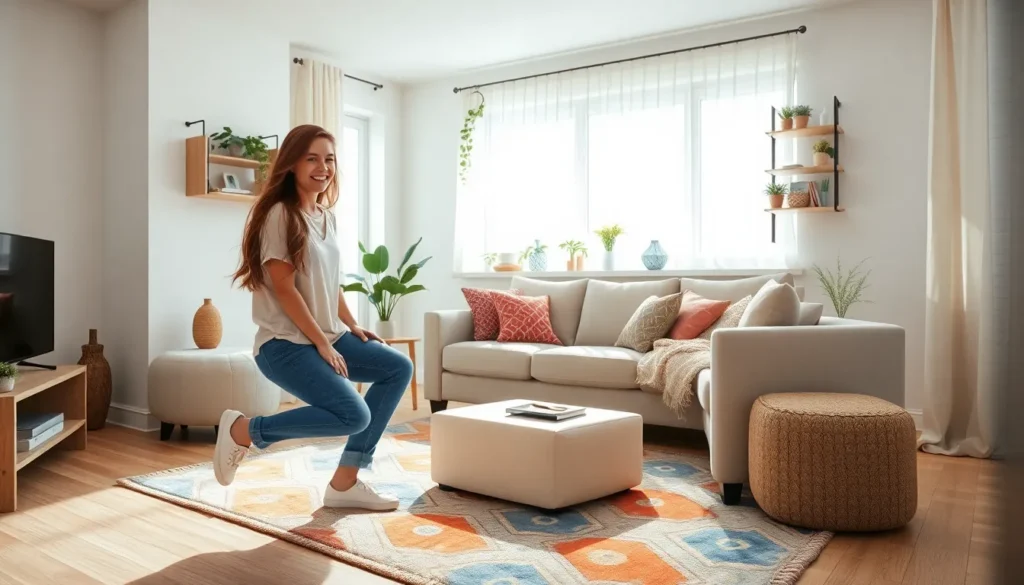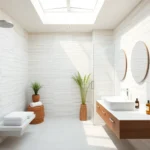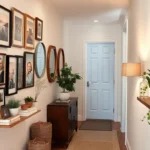Small spaces don’t have to feel cramped or limiting. We’ve all stared at a tiny room wondering how to transform it into something functional and beautiful without very costly or knocking down walls.
The secret lies in smart design choices that maximize every square inch. From clever storage answers to optical illusions that make rooms appear larger, we’ll show you how to turn your compact space into a stylish haven that rivals any grand room.
Whether you’re dealing with a studio apartment, a small bedroom, or a cramped office, we’ve gathered the most effective makeover strategies that deliver impressive results. These aren’t just theoretical concepts – they’re practical techniques that work in real homes with real budgets. Get ready to see your small room’s potential unleashed through strategic design moves that make a big impact.
Maximize Your Space With Smart Storage Solutions
Smart storage transforms cluttered small rooms into organized sanctuaries that feel twice their actual size. We’ll explore three game-changing approaches that create more usable space without compromising style.
Use Vertical Wall Space
Floor-to-ceiling shelving dramatically increases your storage capacity while drawing the eye upward to create height illusions. Install tall bookcases, floating shelves, or modular wall units that reach from floor to ceiling. We recommend positioning frequently used items at eye level and storing seasonal items up high.
Wall-mounted organizers keep daily essentials accessible without consuming precious floor space. Pegboards work perfectly for create rooms, kitchens, or home offices. Magnetic strips hold knives in kitchens or tools in workshops. Over-the-door shoe organizers can store cleaning supplies, toiletries, or create materials.
Vertical dividers separate and organize items within existing storage spaces. Use shelf dividers to stack sweaters neatly or create compartments for documents. Tension rods installed vertically in closets create additional hanging space for pants or skirts.
Install Multi-Functional Furniture
Storage ottomans provide seating while hiding blankets, toys, or seasonal decorations inside. Choose ottomans with removable tops that double as coffee tables or extra seating when guests visit. We’ve found that square ottomans maximize storage volume compared to round ones.
Lift-top coffee tables reveal hidden compartments perfect for remotes, magazines, or board games. These tables maintain their surface function while storing items you need within arm’s reach. Select models with additional lower shelves for books or decorative baskets.
Bed frames with built-in storage eliminate the need for separate dressers in tight bedrooms. Platform beds with drawers underneath store clothing, linens, or off-season items. Captain’s beds with side compartments work especially well in children’s rooms for toys and books.
Create Hidden Storage Areas
Under-stair spaces transform wasted areas into functional storage zones. Install pull-out drawers for cleaning supplies or create a mini pantry with shelving. Custom-built answers maximize every inch, but even simple wire shelving units can organize shoes, sports equipment, or holiday decorations.
Behind-door storage utilizes space you never knew existed. Shallow cabinets behind bedroom doors hold jewelry, accessories, or toiletries. Full-length mirrors with hidden storage compartments serve dual purposes while maintaining room aesthetics.
Hollow furniture bases conceal storage within existing pieces. Ottoman storage cubes nest under console tables when not in use. Bench seating with hinged tops stores shoes in entryways or pool supplies on patios. We recommend choosing pieces that match your existing decor to maintain visual continuity.
Transform Your Room With Strategic Color Choices

Color choices can dramatically transform your small room without major renovations. We’ll explore strategic color techniques that maximize space and create visual impact.
Choose Light and Neutral Paint Colors
Light and neutral paint colors serve as the foundation for making small rooms feel larger and more open. We recommend whites, creams, soft grays, and pale pastels because they reflect more light and create a bright, airy environment that visually expands your space. These versatile shades provide the perfect backdrop for layering other colors and décor elements without overwhelming your small room.
Neutral foundations offer flexibility for future updates and seasonal changes. You can easily switch out accessories and accents while maintaining the spacious feel that light walls create. This strategy works particularly well in studio apartments and small bedrooms where maximizing perceived space is crucial.
Add Pops of Color Through Accessories
Accessories provide the perfect opportunity to inject personality and vibrancy into your small room without compromising space. We suggest using accent pillows, rugs, artwork, and curtains in brighter hues to enliven your room while preserving the openness created by lighter walls.
This approach allows for easy updates and seasonal transformations without the commitment of repainting. Consider rotating colorful throw pillows, switching out artwork, or changing curtain panels to refresh your space throughout the year. Small colorful accessories create focal points that draw the eye without cluttering your visual field.
Use Monochromatic Color Schemes
Monochromatic color schemes create unity and streamline the appearance of small rooms by using varying tones and shades within a single color family. We’ve found this approach reduces visual clutter and creates an elongated, harmonious effect that makes spaces feel more cohesive.
Designers now embrace bold monochromatic approaches, including color drenching techniques where walls, furnishings, and décor share tonal relationships. This intentional color strategy maximizes visual impact and spatial perception, making even small rooms feel memorable and interesting. Bold and dark colors can visually draw the eye and elongate space when applied thoughtfully across all elements in your room.
Enhance Natural Light and Create Brightness
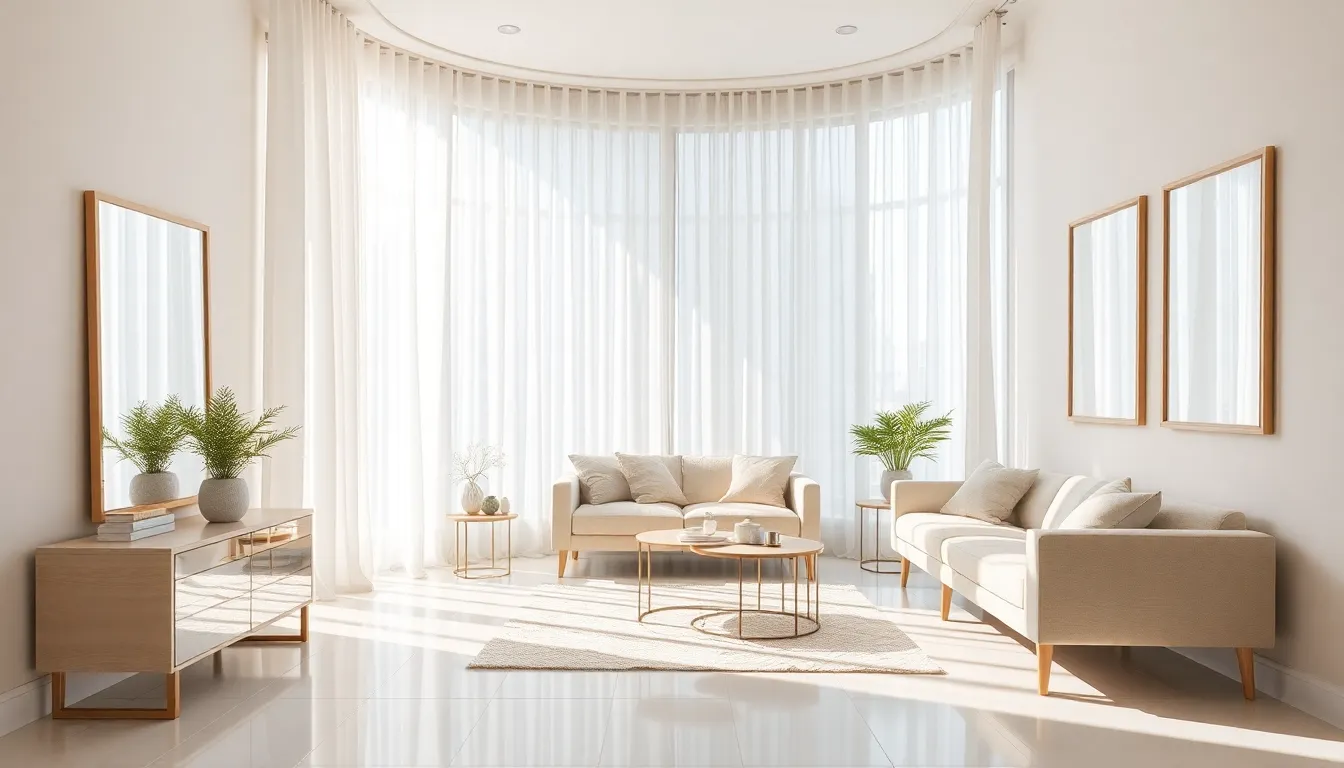
Natural light transforms small spaces into inviting environments that feel twice their actual size. We’ll show you how to maximize every ray of sunlight and amplify brightness throughout your room.
Remove Heavy Window Treatments
Heavy curtains and thick blinds block precious natural sunlight from entering your space. Replace these light-blocking treatments with sheer curtains or simple roller shades to allow maximum sunlight into your room. Light and airy window coverings create a more welcoming atmosphere while making your space appear significantly larger.
Sheer fabrics filter harsh light while maintaining privacy during daytime hours. Simple roller shades offer clean lines that don’t compete with your room’s other design elements. Both options let natural light flow freely while giving you control over privacy when needed.
Add Mirrors to Reflect Light
Mirrors act as natural light amplifiers by bouncing both natural and artificial light around your space. Place large mirrors opposite windows or near existing light sources to maximize their brightening effect and create the illusion of a larger area.
Multiple mirrors positioned at different angles enhance light diffusion throughout your room. Strategic mirror placement doubles the impact of your natural light sources while adding depth and visual interest to your walls. Consider oversized mirrors as statement pieces that serve both functional and decorative purposes.
Choose Light-Colored Flooring
Dark floors absorb light and make small rooms feel cramped and enclosed. Install light-colored flooring options like pale wood, white-washed finishes, or light neutral carpets to reflect more light and brighten your entire space.
Light flooring creates visual continuity with your walls and ceiling while contributing to an open, airy atmosphere. These surfaces work harmoniously with other bright elements in your decor to expand your room’s perceived size. Consider how your flooring choice will complement your furniture and accessories for a cohesive, light-filled environment.
Create Visual Space With Clever Furniture Arrangements
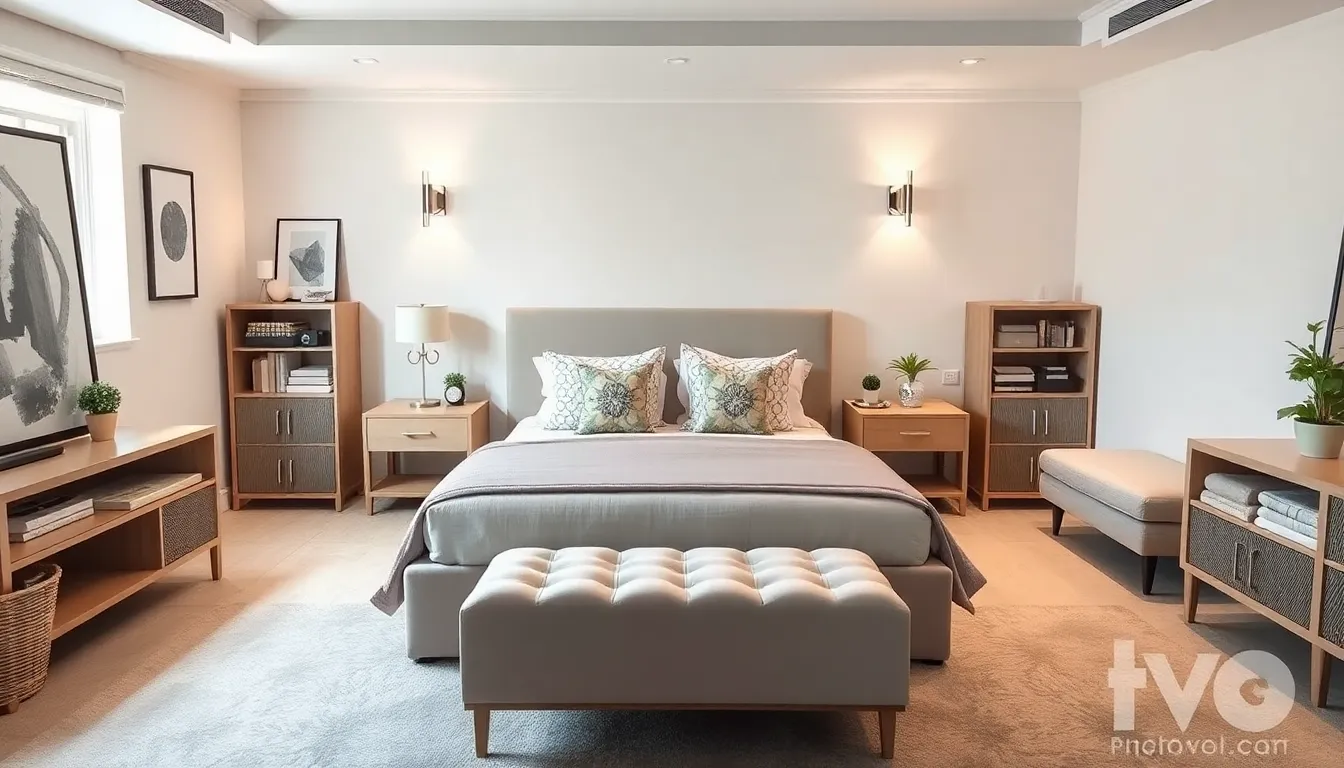
Furniture placement can transform your small room’s visual appeal and functionality more dramatically than you might expect. We’ll explore strategic positioning techniques that create the illusion of more space while maintaining comfort and style.
Float Furniture Away From Walls
Positioning your bed away from the wall creates an immediate sense of openness that many homeowners overlook. We recommend placing your bed in the center of the most visible wall, often facing the doorway, to establish symmetry and encourage better flow throughout the room. This technique breaks up the boxy feel that occurs when all furniture hugs the perimeter.
Floating furniture encourages more creative use of your center space while adding depth to the room’s appearance. You’ll find that this approach creates a more ever-changing and airy atmosphere compared to the traditional wall-hugging arrangement. Consider leaving enough space on each side of the bed for easy movement, which further enhances the room’s spacious feel.
Use Multi-Purpose Pieces
Storage beds with built-in drawers maximize utility while keeping your belongings organized and out of sight. We suggest investing in ottomans with hidden compartments or benches that open for extra storage to minimize clutter without sacrificing functionality. These pieces serve dual purposes, making them essential for small room makeovers.
Multi-functional furniture helps you maintain a streamlined appearance while meeting your storage needs. Examples include nightstands with multiple drawers, coffee tables with lift-top surfaces, or headboards with built-in shelving. Each piece should earn its place by serving at least two functions in your space.
Choose Furniture That Fits the Scale
Low-profile beds and slim nightstands prevent your furniture from overwhelming the room’s proportions. We recommend selecting pieces that complement your room’s dimensions rather than competing with them for visual attention. Wall-mounted lights and floating shelves free up valuable floor space while maintaining the functionality you need.
Appropriately sized furniture creates breathing room that makes your space feel less confining. Lighter-colored pieces work particularly well because they reflect more light and blend seamlessly with your room’s overall color palette. Consider measuring your space carefully before purchasing to ensure each piece enhances rather than crowds your small room makeover.
Add Personality Through Creative Wall Treatments
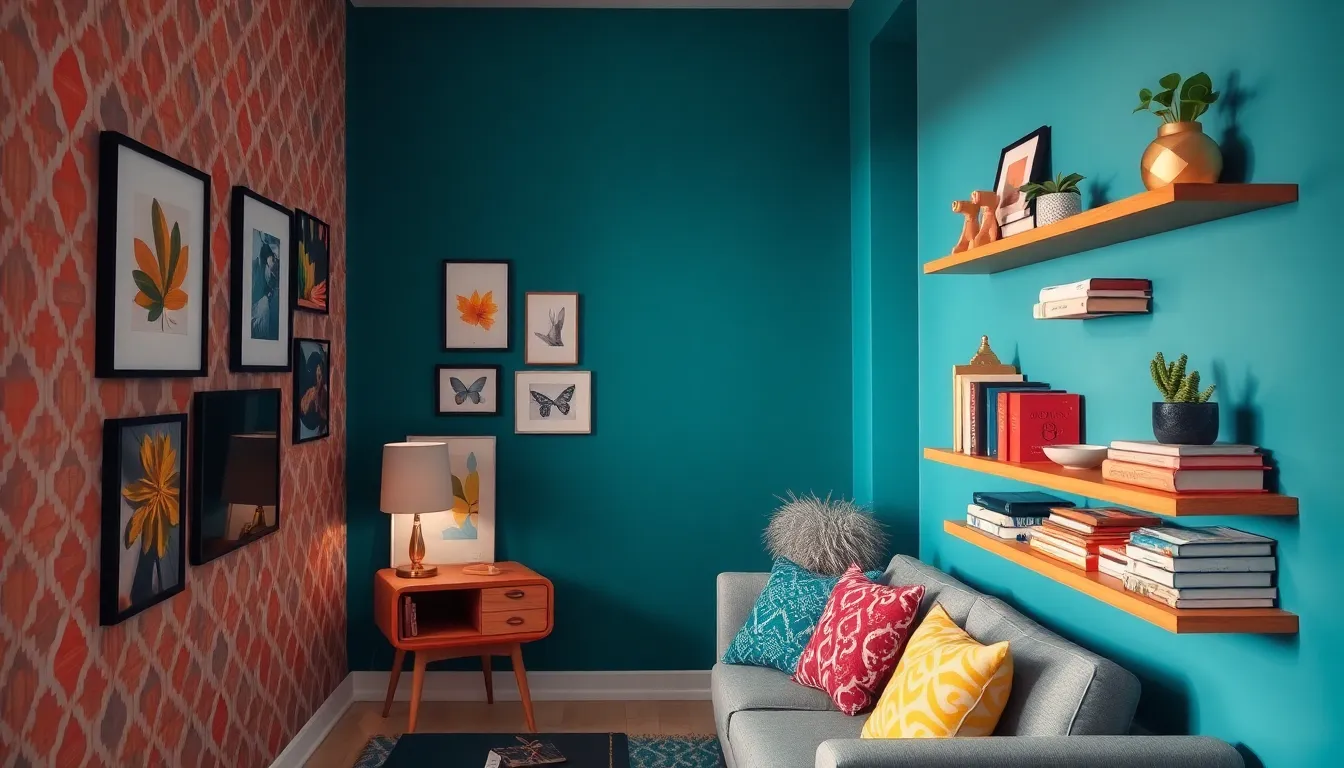
Wall treatments offer one of the most impactful ways to transform small rooms without major renovations. These creative answers add visual interest while maintaining the openness essential for compact spaces.
Install Removable Wallpaper or Decals
Removable wallpaper transforms small rooms with bold patterns or subtle textures that won’t damage your walls. We recommend choosing designs that create optical illusions to make spaces feel larger, such as vertical stripes or geometric patterns that draw the eye upward. Application takes just a few hours, and you can easily change styles when you’re ready for something new.
Decals provide another excellent option for adding personality without permanent commitment. These adhesive designs work particularly well for accent walls or exact areas like behind headboards or desks. We suggest selecting removable options that peel off cleanly, allowing you to experiment with different looks throughout the year.
Create a Gallery Wall
Gallery walls serve as focal points that showcase your personality without consuming precious floor space. We recommend starting with frames of varied sizes and mixing artwork, photos, and meaningful pieces that reflect your style. Arrange pieces on the floor first to perfect your layout before hanging.
Curated collections work best when they tell a story or follow a cohesive theme. Consider mixing different textures like canvas prints, framed photography, and small sculptural elements to add dimension. We find that gallery walls draw attention upward, making ceilings appear higher and rooms feel more spacious.
Use Floating Shelves for Display
Floating shelves maximize vertical space while providing essential storage and display opportunities. We suggest installing them at varying heights to create visual interest and accommodate different sized items like books, plants, and decorative objects. These shelves keep surfaces clear, which is crucial for maintaining an uncluttered feel in small rooms.
Strategic placement enhances both function and aesthetics in compact spaces. Consider positioning shelves above furniture pieces or in corners to use otherwise wasted wall space. We recommend styling them with a mix of practical items and decorative pieces, ensuring each shelf serves both storage and visual appeal purposes.
Optimize Your Layout for Better Flow

Creating an effective layout in small rooms requires strategic furniture placement that promotes easy movement while maximizing every square foot. We’ll focus on streamlined arrangements that eliminate visual clutter and enhance the sense of openness.
Define Zones in Open Spaces
Multifunctional furniture creates distinct areas without sacrificing precious floor space. Daybeds work exceptionally well for this purpose, serving as comfortable seating during the day and transforming into sleeping areas at night. We recommend positioning a daybed against the longest wall to anchor your main living zone while maintaining clear sight lines throughout the room.
Repurposing existing architectural features maximizes functionality without major renovations. Closets and alcoves become perfect workspace zones when fitted with floating desks and adequate lighting. Area rugs help visually separate these dedicated spaces from the main room, creating boundaries that don’t require physical walls.
Strategic lighting defines zones more effectively than furniture placement alone. Different lighting levels—such as task lighting over a workspace and ambient lighting in seating areas—naturally guide the eye and create distinct functional zones within your small room.
Create Clear Pathways
Wall-hugging furniture arrangements keep pathways completely unobstructed. Floating shelves and wall-mounted storage eliminate floor obstacles while providing essential storage and display space. We suggest measuring a minimum 36-inch walkway width to ensure comfortable movement throughout the room.
Under-bed storage answers maintain clear floor space while maximizing storage capacity. Rolling storage bins and vacuum-sealed bags tucked beneath beds keep seasonal items organized without creating pathway barriers. This approach preserves the visual flow while doubling your storage potential.
Minimal decorative elements prevent pathways from feeling cramped or cluttered. We recommend limiting floor decorations to one or two statement pieces, such as a single large plant or sculptural element, rather than multiple smaller items that fragment the space.
Position Furniture for Conversation
Face-to-face seating arrangements create intimate conversation areas without blocking traffic flow. Even in compact bedrooms, grouping a daybed with a small accent chair or storage ottoman establishes a cozy gathering spot. We position these pieces at slight angles to maintain sight lines while encouraging natural conversation.
Multifunctional seating maximizes both social and storage needs simultaneously. Storage ottomans provide comfortable seating for guests while concealing blankets, books, or other essentials inside. This dual-purpose approach eliminates the need for additional furniture pieces that might overcrowd the space.
Strategic placement near natural light sources enhances the conversational atmosphere. We recommend positioning seating areas within 6 feet of windows when possible, as natural light creates a more inviting environment for social interactions while making the space feel larger and more open.
Incorporate Greenery and Natural Elements
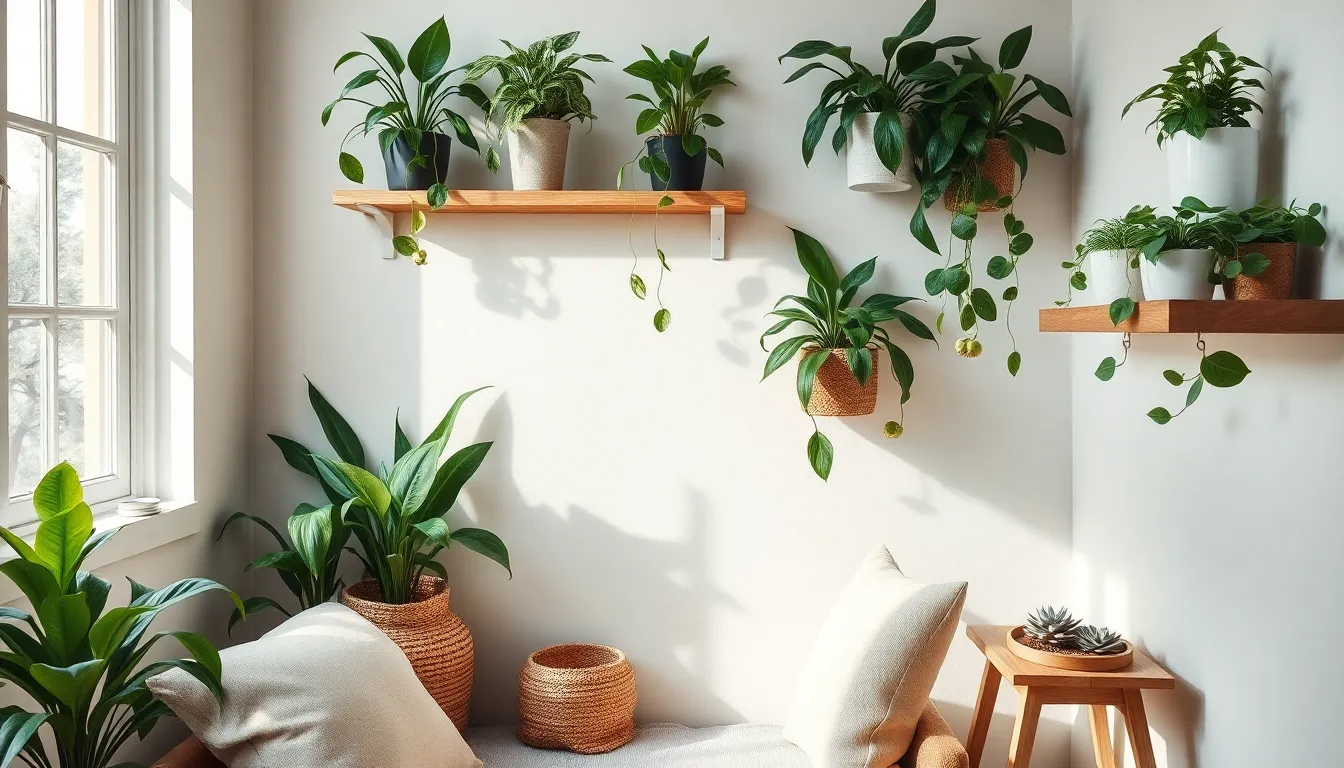
Plants and natural materials create a fresh, calming atmosphere while maximizing space in small room makeovers. We’ll explore how greenery connects your room to nature and enhances well-being through strategic placement and selection.
Choose Space-Saving Plants
Compact varieties work best for small spaces without overwhelming your room’s design. Snake plants and pothos thrive in various light conditions and maintain their appeal with minimal maintenance requirements. These low-maintenance options fit perfectly on floating shelves, narrow windowsills, or mounted wall planters while keeping floors clear.
Vertical growing patterns help draw the eye upward and make ceilings appear higher. Trailing vines and hanging plants cover bare corners and walls effectively. Air plants in terrariums and small succulents require minimal space while adding natural beauty to shelves and tabletops.
Strategic placement maintains an open feel throughout your space. We recommend positioning plants on wall-mounted holders rather than floor-standing pots to preserve walking areas. Corner-placed plants in hanging baskets create focal points without sacrificing precious square footage.
Add Natural Textures
Woven materials introduce warmth and visual interest without creating clutter in small spaces. Baskets provide both storage and organic texture while serving multiple functions. Linen fabrics on cushions and throws add softness that complements your plant selections.
Wood elements create cohesive, organic looks when paired with green walls or plant accents. Natural wood tones in furniture pieces anchor your space while maintaining an earthy aesthetic. Bamboo accessories and reclaimed wood shelving enhance the natural theme without overwhelming compact areas.
Layered textures build depth and personality in small room makeovers. Combining smooth ceramic planters with rough jute rugs creates tactile variety. Natural fiber wall hangings and wooden picture frames complete the organic atmosphere we’re cultivating.
Use Plants as Room Dividers
Tall specimens like fiddle leaf figs and bamboo palms act as living screens to separate different areas subtly. These plants create privacy while maintaining airy sightlines throughout your space. Living dividers offer flexibility that traditional walls cannot provide in small areas.
Vertical arrangements delineate zones without building permanent structures. Multiple hanging plants in a series create natural boundaries between sleeping and working areas. Plant holders arranged vertically establish distinct spaces while preserving floor area for movement.
Strategic positioning enhances functionality while adding greenery to your small room makeover. We suggest placing divider plants where they’ll receive adequate light while serving their spatial purpose. This method keeps your room feeling spacious and connected to the outdoors while defining different functional zones.
Upgrade Your Lighting for Ambiance and Function

Lighting transforms small rooms from cramped spaces into inviting havens that feel larger and more functional. Strategic lighting choices work alongside our natural elements and thoughtful color schemes to complete your small room makeover.
Layer Different Types of Lighting
Combining ambient, task, and accent lighting creates depth and dimension that makes small spaces feel more expansive. Ambient lighting from ceiling fixtures like flush mounts or semi-flush mounts provides overall illumination without overwhelming compact rooms. Task lighting through adjustable wall sconces or swing arm lamps delivers focused brightness for reading or working areas. Accent lighting using small wall sconces, LED strips, or plug-in pendant lights highlights artwork and architectural features while creating visual interest throughout your space.
We recommend installing this layered approach to eliminate harsh shadows that can make rooms feel smaller. Each lighting layer serves a exact purpose while contributing to the overall atmosphere you’ve carefully crafted with your color choices and natural elements.
Install Space-Saving Light Fixtures
Wall-mounted and recessed lighting fixtures maximize your room’s footprint by eliminating bulky floor and table lamps. Wall sconces free up valuable surface space while delivering ample illumination exactly where you need it. Recessed ceiling lights provide bright, even coverage without intruding into your carefully planned layout and furniture arrangement.
These space-saving answers work particularly well in rooms where you’ve already optimized storage and furniture placement. Wall-mounted fixtures complement your vertical storage strategies while maintaining the clean lines that make small spaces feel open and organized.
Use Portable Lighting Options
Portable lighting answers offer flexibility that permanent fixtures can’t match in small room makeovers. Plug-in pendant lights, small portable lamps, and battery-operated LED lights can be repositioned as your needs change throughout the day. These options require no permanent installation, making them perfect for renters or anyone wanting to experiment with different lighting arrangements.
Battery-operated LED lights work especially well behind shelves or under cabinets, providing gentle indirect illumination that enhances your space-saving storage answers. Portable lamps can be moved to highlight different areas of your room, supporting the various zones you’ve created through strategic furniture placement and area rugs.
Conclusion
Transforming your small space doesn’t require a complete overhaul or massive budget. With these strategic approaches we’ve outlined you can create a room that feels both spacious and stylish while meeting all your functional needs.
Remember that every small change contributes to the bigger picture. Whether you’re implementing smart storage answers choosing lighter colors or optimizing your lighting setup each decision works together to maximize your space’s potential.
The key lies in being intentional with every design choice. By focusing on multi-functional elements strategic placement and visual tricks that enhance natural light you’ll discover just how much possibility exists within your compact living area.
Start with one or two techniques that resonate most with your space and gradually build from there. Your small room makeover journey begins with that first thoughtful step.
Frequently Asked Questions
What are the most effective storage solutions for small spaces?
The three key approaches are utilizing vertical wall space with floor-to-ceiling shelving, investing in multi-functional furniture like storage ottomans and lift-top coffee tables, and creating hidden storage areas such as under-stair spaces and behind-door organizers. These solutions help transform cluttered areas into organized sanctuaries while maximizing every inch of available space.
Which paint colors work best for making small rooms appear larger?
Light and neutral colors like whites, creams, and soft grays are most effective for creating a bright, airy environment that visually expands small spaces. These colors serve as flexible backdrops for colorful accessories and can be enhanced with monochromatic color schemes using varying tones within a single color family to reduce visual clutter.
How can I maximize natural light in my small room?
Remove heavy window treatments and replace them with sheer curtains or simple roller shades to allow maximum sunlight. Strategically place mirrors to reflect light and create the illusion of more space. Additionally, choose light-colored flooring options that reflect light and contribute to an open, bright atmosphere throughout the room.
What furniture arrangement techniques work best for small spaces?
Float furniture away from walls, such as positioning beds in the center of the most visible wall, to create openness and improve flow. Choose appropriately scaled, low-profile furniture and select lighter-colored pieces. Multi-purpose furniture like storage beds and ottomans with hidden compartments help minimize clutter while maximizing functionality.
How can wall treatments enhance small spaces without major renovations?
Use removable wallpaper or decals to introduce bold patterns that create optical illusions, making rooms feel larger. Create gallery walls as focal points that showcase personal style while conserving floor space. Install floating shelves to maximize vertical space for both storage and display, contributing to a stylish and organized environment.
What lighting strategies make small rooms feel more spacious?
Layer different types of lighting—ambient, task, and accent—to create depth and dimension. Choose space-saving fixtures like wall-mounted and recessed options to maximize floor space. Use portable lighting solutions for flexibility, allowing you to reposition lights as needed to enhance functionality and create an inviting atmosphere in compact areas.

